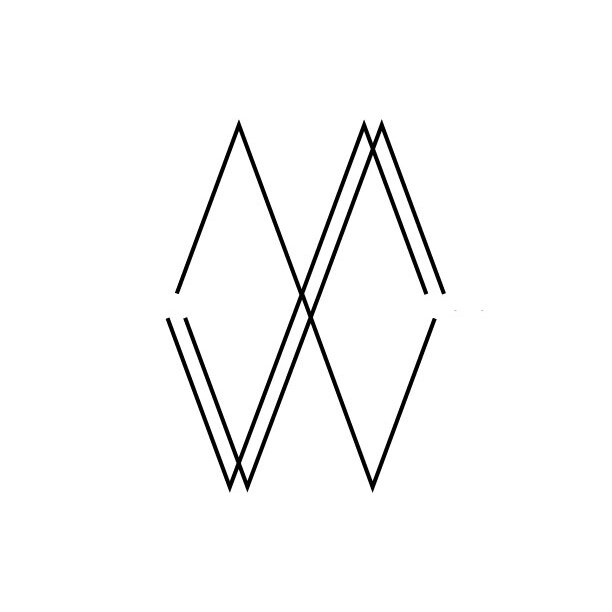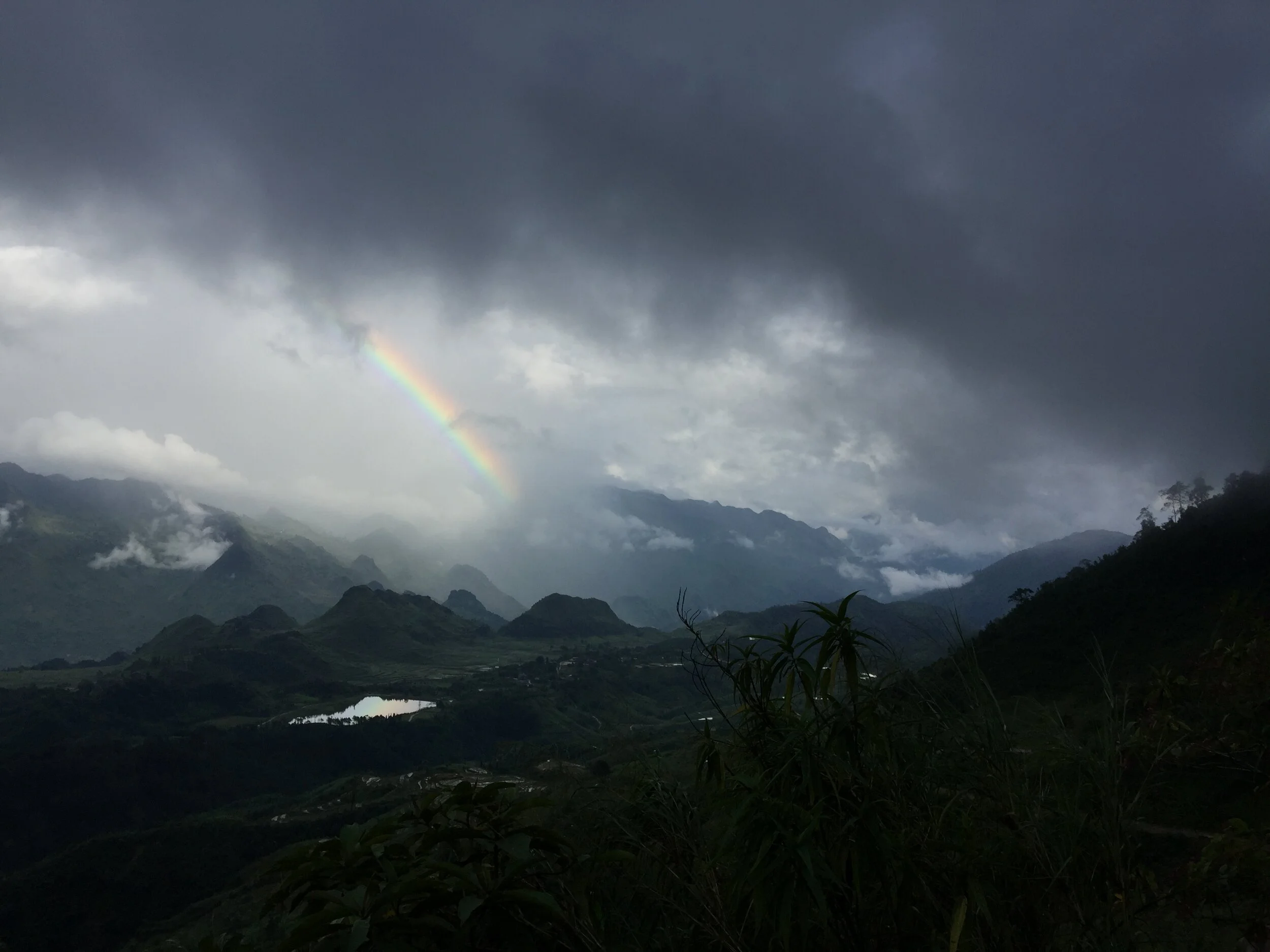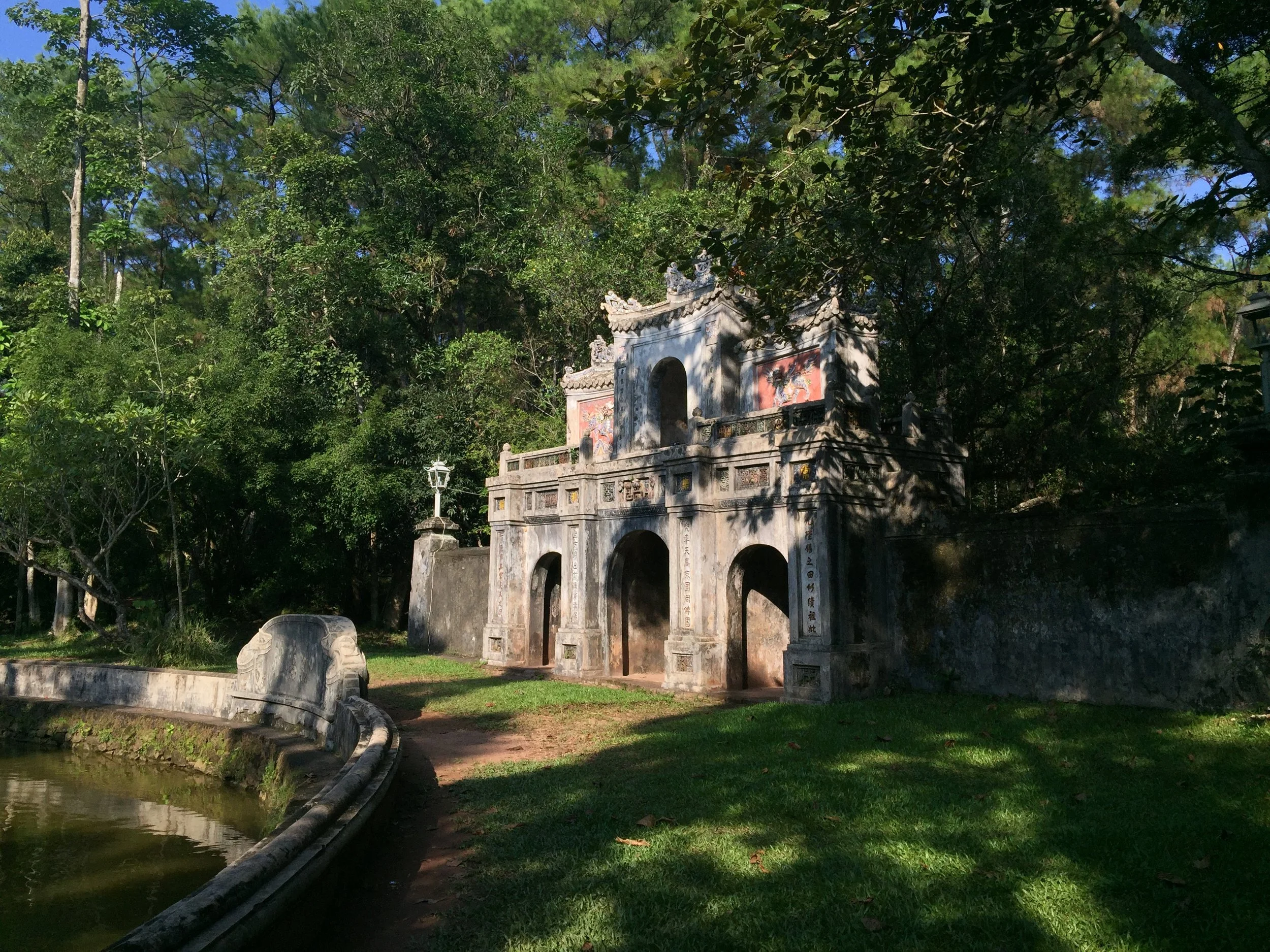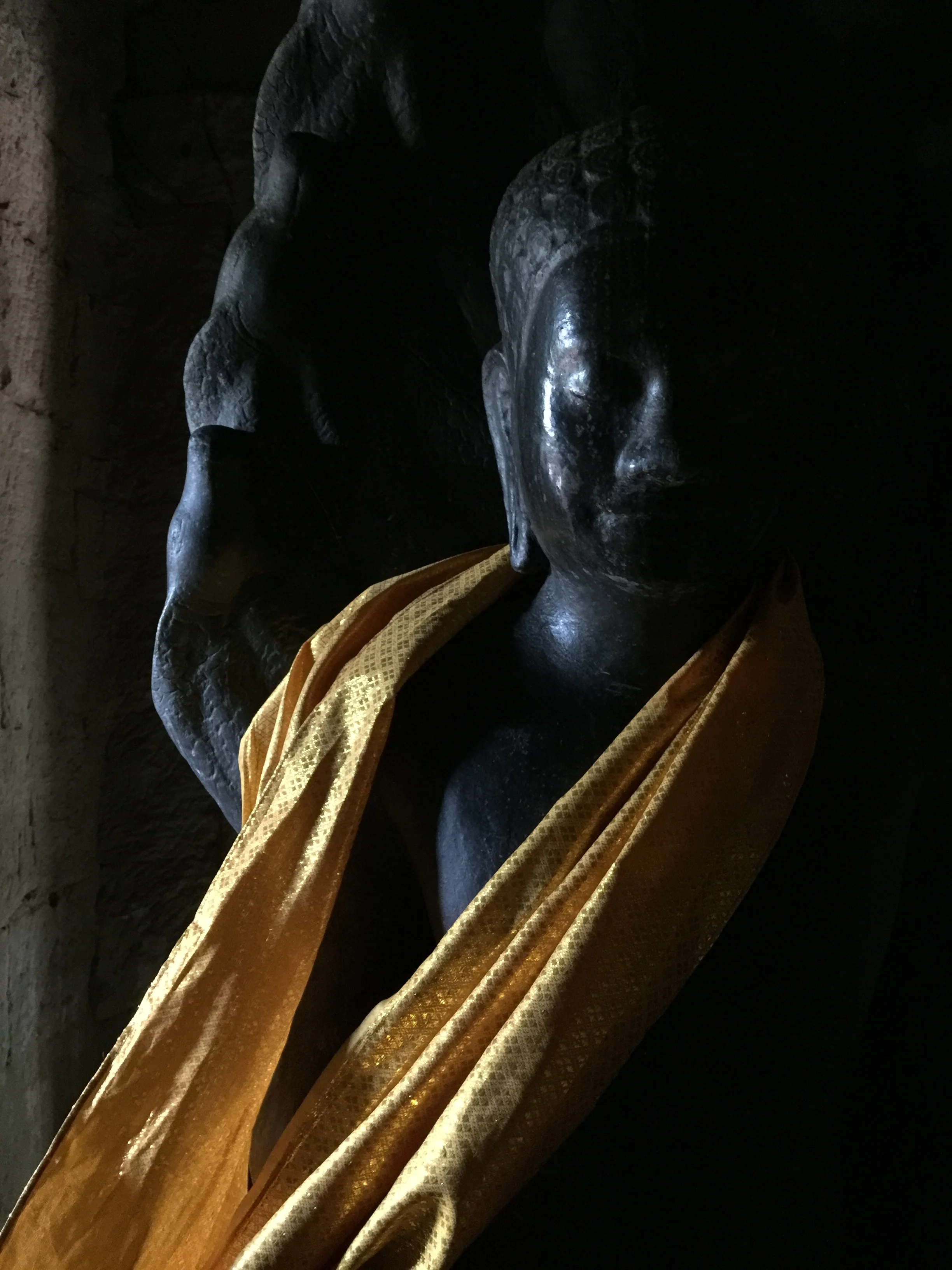Rainbow over Ha Giang, Vietnam, 2018.
To be alive means that we are in a constant state of homeostasis. Part of maintaining our physiological balance requires breathing. You can survive for three weeks without food and about three days without water, but we’re granted only three precious minutes without breathing before we will expire. So important was the breath to the ancient Chinese that they encoded it in their numerical system. The character for the number four makes the shape of a nose and nostrils to represent the act of breathing. It also happens to sound like the word for death. In many cultures, the number four symbolizes completion. What is a human without breath but incomplete?
“What is a human without breath but incomplete? ”
Today, breathing well is hard. While the pandemic improved air quality around the globe, the air quality index has surged again with devastating west coast fires and our swift return to productivity. According to James Nestor, author of Breath: The New Science of a Lost Art, it’s not just the fires on the west coast or our insatiable consumer appetite making it hard to breathe. It’s us.
It seems implausible at first, but Nestor makes a compelling case navigating research that suggests our evolving anatomy has resulted in a shift from nasal to mouth breathing. This change has had devastating consequences. Scientists blame mouth breathing for the rise of snoring, sleep apnea, asthma, allergies, hypertension, and even autoimmune disease. To understand how we became a culture gasping for air, Nestor travels back in time and up his nose to make a case that ancient medicine, the “lost art” part of his subtitle, can resuscitate how we breathe.
Nestor is no slouch when it comes to researching how humans breathe. He’s done it before in DEEP: Freediving, Renegade Science, and What the Ocean Tells Us about Ourselves, which examined the amphibious abilities of freedivers. No surprise. They are great breathers. The book also served as the foundation for this book. Just as Nestor embeds himself with extreme athletes in DEEP, he makes himself a subject again in Breath when he joins a 20-day breathing study at Stanford University, which he describes at times to comic effect. This study, and his participation in it, flows the length of the book, but the headwater begins ten years before when a doctor recommends breathing exercises for Nestor’s respiratory problems. He’s ready to reclaim his life. At times feeling like a search for the holy grail, Nestor delivers on his introductory statement that the book “is a scientific adventure into the lost art and science of breathing.”
Like Nestor, I sought medical advice to feel better when I hit a slump in my life. At the time, I lived in Hanoi, a city whose average air quality meant that on most days I would hover over a purifier to huff clean air. Wearing a mask only did so much. I became a shut-in who dreaded even a walk to the corner bodega for fear I’d be drained. Most days I was. After fruitless visits to a Western medicine hospital, I chose to see a traditional Vietnamese doctor. Lying on the examination table, the doctor tutted over me. After watching me breathe for several minutes, she concluded that the problem wasn’t my environment: it was my breath. I asked what the prescription might be, expecting her to needle me and send me home with herbs.
“Come tomorrow for qigong. I will teach you.” With my next inhale, I came alive with the possibility of breathing better — whatever that meant.
Nestor received a similar prescription from his doctor to join a class to learn the breathing technique called Sudarshan Kriya. Like qigong and the thousands of methods like it, the technique trains people to take in air in a way we’re not accustomed to: cyclically and rhythmically. And perhaps most importantly, with intention. From this foundation in traditional healing practices, Nestor vacillates in time to uncover the earliest and latest “plumonauts,” a term he uses to define those researching breathing and their methods to improve it.
When looking for any lost thing, the first step is to recall where you last left it. In the case of breathing, all compasses point to the East. It doesn’t matter where the plumonaut in question lives, their work is built upon a foundation of several millennia-old Eastern texts which viewed proper breathwork as preventive medicine.
“When looking for any lost thing, the first step is to recall where you last left it.”
This is something I know first-hand. When I read Breath, I was in my first year of medical school at Shanghai University of Traditional Chinese Medicine in China. After learning qigong from my Vietnamese doctor, I wanted to know more about this ancient practice. A year later, I moved to Shanghai to study with Dr. Chen Chang Le, a qigong master and acclaimed physician at the Shanghai Qigong Institute. Breath is his specialty. His classes on qigong form the basis of his research, but his practice of it likely accounts for his chill vibe, too.
Just as there are many techniques for breathing, there are many forms of qigong. The one I practiced with Dr. Chen was a version we could easily teach people. We planned to study the physiological effects of casual, but regular qigong practitioners. Unwittingly, I became a plumonaut, gaining access to a community of people obsessed with breathing. What I discovered, that Nestor’s writing affirms, is that we aren’t looking for hacks, nor do we appreciate our rigorous work filed under “New Age.” Like me, the people I met were serious researchers intent on improving human well-being. We view our work as a calling, and doing so within a community that understands it as such, is essential.
Sangha is the Sanskrit word for "community." Buddhist teacher and monk Thich Nhat Hanh writes that “Without being in a sangha, without being supported by a group of friends who are motivated by the same ideal and practice, we cannot go far.” Traditional medicine, the “lost art” Nestor is referring to, requires an attentive and supportive community to flourish and grow. It is impossible to read Breath without jumping to the end of the book, where an extensive resource section then leads you to Nestor’s website. More than serving its purpose of brand awareness, it has become like an Alexandria of breathing libraries, but it’s also a hub for a community of people who wish to become better breathers.
“We view our work as a calling, and doing so within a community that understands it as such, is essential. ”
That’s how I learned that Chuck McGee, one of the particularly colorful characters Nestor spends time with in Breath, was hosting a free, online class to learn more about the Wim Hof Method. Wim Hof has become a guru in the wellness industry, his acclaim reaching as far as China if you count my classmate’s obsession with taping her lips while sleeping — a method Hof talks about. Or better, that I download his app. He has one of those too. Hof is the self-taught, extreme-athlete also known as “Ice Man” because he broke the Guinness World Record for prolonged contact with ice while swimming under it. Since then, Hoff’s fame has grown with the eponymously named method he created to improve overall wellness, which incorporates cold exposure, breathing techniques, and meditation. It’s this method that McGee traveled to Poland to study. Since learning the Wim Hof Method, McGee began teaching the breathing portion of the technique in person, then moved online with the COVID-19 pandemic.
On a Monday evening, I joined his free class along with nearly 200 other curious people from around the world. Nestor was silently present in the Zoom call, too. For the first half-hour, McGee explained the process and technique, beginning with an informal medical disclosure. We moved on to the breathing exercise, which resembled the way Nestor describes it in his book. After the first round, I went deaf. A chatter of crickets erupted in my ears, and the upper area of my chest became hot and prickly. My ears grew warm. Surprisingly, my nostrils chilled with every inhalation. After holding in the air following the second breath, my upper arms became like logs, and felt paralyzed. When McGee ended the session, I was pretty sure that if I stood up, I would pass out. Despite all of this, I felt calm, utterly so.
Ideally, this, and all the breathing techniques Nestor covers, should be done with extensive and careful instruction. These aren’t techniques to be mastered overnight. They take years, if not decades. Although Nestor takes the position of the skeptic throughout the book, his respect for each breathing technique is evident. His research methodology seems meticulous and the phrase “consult a doctor” is peppered throughout. Some techniques, he notes, especially those that require restrictive breathing, can be dangerous. Tummo, the technique from which Wim Hof developed his method, is one of them.
∆
Later, I asked Dr. Nida “Dr. Nida” Chenagtsang, a Tibetan Medicine doctor and teacher of the tummo or “inner fire” mediation, about my experience with the practice. Mostly he thinks it's good that tummo breathing is being shared. For more advanced levels though, he’s wary.
“If somebody doesn’t know what is happening energetically or mentally, or if you don’t know the inner transformation and process, then it can be dangerous,” he said. Tummo, after all, isn’t just about breathwork, it’s a part of a system within Tibetan Traditional Medicine.
The energy that Dr. Nida is referring to is the “life force,” a term that has various names in different cultures, including prana, qi, pneuma, ki, orenda, ruah, etc. Although no one has yet confirmed that it exists, numerous studies, including the one I began working on, have tried to measure aspects of it. Lifeforce is the foundation of traditional medicine around the world. More recently, attempts by individuals to monetize some aspects of these ancient medicine practices are concerning. Traditional medicine isn’t meant to be practiced piece-meal. Novice practitioners, without the proper guidance, can seriously harm themselves.
Dr. Nida explained that forced and restrictive breathing, which are considered advanced practices, can result in panic attacks or psychosis. Therefore, a method like tummo requires the proper setting and teacher. Dr. Nida, for his part, instructs regular classes online, and before COVID-19, in retreats, but he has also written extensively on breathing techniques. In short, he advises people to learn simple breathing exercises to acquaint themselves with breath and body. In its Appendix, Nestor outlines all the breathing techniques the book covers, including others that didn’t “make the cut” but that he regularly practices. Taking Dr. Nida’s recommendation, novice breathers might select an observational breathing technique like nadi shodhana, breathing coordination, or resonant breathing. Tummo or any of the restrictive techniques should be practiced only after mastering basic techniques.
“If somebody doesn’t know what is happening energetically or mentally, or if you don’t know the inner transformation and process, then it can be dangerous.”
Another key point of Breath is that our lifestyle shapes us, sometimes to our detriment. To address this point, Nestor offers a delightful exploration of the human species’ nasal and oral evolution. I had a hunch our noses have evolved — or devolved, depending on the snout you inherited. From within the caverns of Nestor’s nasal passages and equally dark catacombs of Paris, we learn why breathing well is getting harder for humans to do. One idea is that our difficulty breathing is closely tied to the boom of industrialized agriculture and processed food. That wonderful, soft white bread doesn’t just wreak havoc on our waistlines, it also weakens the structures in our body that help us breathe.
Although Nestor spends less time explaining this research, he nonetheless embeds himself in it by wearing a special retainer for a year to increase the size of his mouth. His experience adds to the growing body of evidence that we are not entirely at the mercy of our genetic inheritance. If you aren’t keen to wear orthodontics for a year, then Nestor has you covered. He includes a brief, but a valuable section in the Appendix on eating “rougher, rawer, heartier” foods. I felt less guilt devouring several loaves of pandemic sourdough bread when I knew it had the added bonus of strengthening my jaw. Doing so was making me a better breather.
Beyond offering practical, ancient advice, Breathe is an invaluable tool in a time of upheaval, when statements like “I can’t breathe” spoken by Eric Garner (now a Black Lives Matter slogan) permeate the headlines, when the smoke from epic flames chokes the west coast, or when masks that obstruct our breathing have become part of our face. Nestor begins with an epigram culled from an engraving from the Zhou Dynasty, a dynasty that lasted longer than any other in Chinese history, and was notably famous for the beginnings of Daoism and Confucianism. It warns that when breathing, “the inhalation must be full.” The engraving further warns that anyone who acts against this wisdom will die. It sounds harsh, but the ancient Chinese sages understood the power of breath, that it was essential. To take a “full inhalation” or "deep breath” isn’t a platitude. It’s daily medicine.
∆
Thanks for taking the time to read my work. If you connected with this story, then sign up for my monthly newsletter.








